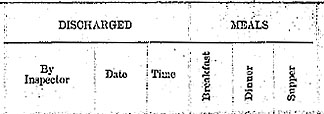 |
| Columns on the left hold reference information . . . |
 |
Information in the left columns connect the detention record to the main ship passenger list
record. Included are the immigrant's name and a reference to the group (page) and line number
where his or her passenger list record is found. Since other passengers dependent on the
detained immigrant would also be held, two more columns show the number of immigrants, by age,
detained with the principal passenger.
|
| Columns in the middle tell why, and what happened . . . |
 |
|
Immigrants detained faced only minor obstacles to their admission. The most commonly detained
immigrants were women traveling alone (or with her children), destined to a husband, fiance,
or male relative. These women could not be admitted without assurance that someone would care
for and protect them. A woman may have been held to wait for her husband to come collect her,
or to wait until a response was received to a telegram informing her husband or relative of her
arrival. Once it was known someone expected her, she could be sent forward via rail to her
destination. The "Cause of Detention" in these cases usually reads "to husb[and]," or to father,
mother, sister, brother, brother-in-law (b-i-l), uncle, etc. Then, in the "Disposition" column,
one will read the name and address of the person to whom the immigrant was released, even if that
person is at an address far from Ellis Island. If this information is preceded by the initials
"R.R.," it means the passenger was sent forward via rail.
Often, immigrant aid societies took charge of these women (or children traveling alone) and
guaranteed immigration officials of the immigrants' safe arrival at their proper destination.
In these cases, the person to whom the immigrant was released may be the name of the aid society,
such as "Hebrew Society," "Irish Home," etc.
Another common cause for detention was an immigrant's lack of tickets through to his or her final
destination. The cause listed in these cases is typically "to Tel $," meaning a telegram had
been sent to their relatives to send money for transportation fare. Once received, the immigrant
was ticketed and released.
One will often see a time noted at top or at various points down the "Cause" column. This is the
time of day (on the date noted at the top of the list) when the immigrant was detained.
|
| Columns to the right record who, when, and how much . . . |
 |
|
The government also used the Record of Detained Aliens to capture administrative information.
The "Discharged" column showed the name or initials of the Immigrant Inspector who decided to
release the immigrant, which allowed for review of his work and decisions. The date and time
of discharge not only recorded more information about the disposition of the individual case,
but also contributed to statistics covering the average length of detention by cause, by
nationality, or by Inspector.
The "Meals" column shows the number of breakfasts, lunches, and dinners consumed by each detained
immigrant. This data was used to compute the monthly bills to steamship companies, who were
responsible for the detention expenses of each excludable immigrant they brought to United States
ports of entry.
|
|




